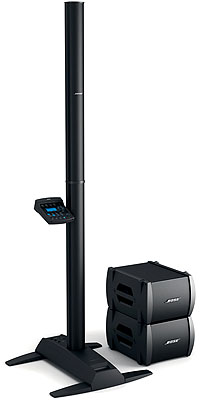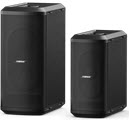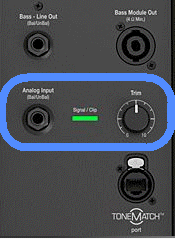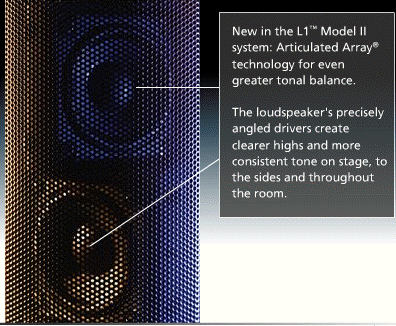L1® Model II
Contents
|
Firmware Updates
| |||||||||||||||||||||||||||||||||||||||||||||||||||||||||||||||||||||||||
|
How to Tell the Difference Between Bose Portable PA ModelsThis is how to tell which L1®, S1 Pro, or F1 unit you have.
Compatibility with Other Members of the L1® Family of ProductsCylindrical Radiator®sCylindrical Radiator®s are not interchangeable across modelsSpecifically (and without exception)
T1 ToneMatch® Audio Engine, T4S/T8S ToneMatch® Mixers
PackLite® power amplifier Model A1
B1 Bass Module
B2 Bass Module
| ||||||||||||||||||||||||||||||||||||||||||||||||||||||||||||||||||||||||||
FAQs
NOTE: these will be moved to a new page when there are more of them.
Analog Input
The Analog input is a ¼ inch balanced input jack. There is a trim control.
Gain Staging
Q: What is the proper method for setting the gain on a Model II power stand when connected to an analog source?
A: While playing your instrument or audio source as loudly as you would in performance, adjust the trim level on the power stand until you see the LED go from yellow to red. Then back the trim level off until the signal LED is predominantly yellow with brief peaks into red.
Stereo Source to Power Stand Analog Input?
Q: Can I run a stereo signal with a ¼ inch Tip-Ring-Sleeve connection to the L1 Model II Analog Input?
A: This is not recommended, and may result in very little sound.
MikeZ-at-Bose [1]
- A bit more clarification - if you plug a true stereo TRS into a model II analog input you'll actually get VERY little sound.
- Since the analog input is balanced, it actually will subtract the Left from the Right (this is how balanced inputs have less noise...I could explain more if anyone is interested). For many recordings, this ends up being very little sound.
- Just wanted to clarify - you cannot 'get through the gig' this way if you're a DJ or needing to run prerecorded music.
Analog Input for Second T1 ToneMatch Audio Engine
The L1 Model II will support two T1 ToneMatch Audio Engines. See T1 ToneMatch™ Audio Engine / Connections to Model II for details.
Start Up / Cycle Time
The model II takes a few seconds to fully boot up and then turn the audio on. Make sure you are waiting the right amount of time.
Secondly, if you do reset the system for some reason, be sure to wait a full two or three seconds between turning it off and turning it back on.
- MikeZ-at-Bose[2]
Fan Noise
Q: The fan in the Power Stand comes on when I strike a chord on my Guitar. Is this normal? A: Your unit is functioning properly - no problem.
The fan in the Model II Power Stand comes on when the input signal level goes over a certain limit, regardless of what the internal temperature of the unit is. That way, the unit never gets too hot to where a fan needs to be on constantly.
Whatever you do, please don't cover up the fan port.[3]
There is a Firmware Update that addresses the fan behaviour. See: L1® Model II Power Stand Firmware Updates#Fan_Behavior
Height
The fully assembled height of the L1 Model II is 84 inches. (213.36 cm)
Clearance required to assemble is approximately 87.5 inches. (222.25 cm)
Input Panel
- Analog input, trim control and signal/clip LED
- Line-level analog input accepts 1/4" TRS phone cable. Can be used for instruments or other audio sources like DJ mixers, MP3 players, computers or DVD systems. Trim control lets you adjust the level of analog input signal. Signal/clip LED indicates status of analog input signal.
- Bass module out
- Delivers amplified bass output signal to one or two B1 bass modules. L1 system automatically adjusts equalization appropriately when bass modules are connected.
- ToneMatch™ port
- Digital audio and power connection for ToneMatch audio engine. Use with included ToneMatch cable.
- Bass line out
- Post-DSP bass signal output. Accepts 1/4" TRS phone cable. Use to connect PackLite® amplifier with up to two additional bass modules. Can also be used to connect powered subwoofer or additional amplification system.
No Speakers Attached
If you want to record using USB without using the L1 Cylindrical Radiator® loudspeaker or B1 Bass Module ...
You can certainly run the L1 with all, some, or none of the speakers connected. With no speakers connected it will happily serve as a big power supply for the T1. You are in no way risking damage to the unit by doing this.[4]
L1™ Model II Power Stand/Bass Line Out
Articulated Array®
Articulated Array
|
The articulated array was introduced with the L1 Model II announced March 29, 2007. This is a collection of notes and quotes about the articulated array, primarily from people-at-Bose. (alphabetical order by author) |
Chris-at-Bose
When Cliff invented the first L1 , we all agreed it was a stunning solution to a terrible problem. The strong consensus on this forum over several years agrees with that. Making it into a product involved countless design decisions, many of them very hard to make. But one thing was clear--the array was a solution that worked; it didn't need "fixing", compared to all the other open questions whose answers were so obscure. So we worked on the murky questions, not on the array.
Once we had the product on the market, we began to learn how it could be even better, mostly from all of you on this forum. We told you we were listening and the L1 Model II is the result of that. When articulating the array was suggested by us, we were all pretty sure it would not work well in this kind of array. It was a long shot, but we tried it anyway and it worked better than any of us expected. Another theory in the dustbin. Breakthroughs sometimes happen and this was one of them, albeit a small one. So now we bring you the L1 Model II, with all our latest knowledge.
-- Chris-at-Bose, July 17, 2007
Cliff-at-Bose
At full chat, the L1 Model II is about as loud as the L1 Classic in front but definitely louder off to the side, due to the extra bit of spectrum wrap we got with the articulated array. Plus, we did all this with less power by the application of Real Science: a far better impedance match to the amp, a better amp, better power control processing and an improvement in the acoustical package. As a result, the new Power Stand is lighter. Sort of like the car engines from the 1930's can't touch today's lighter-weight EFI engines. The new unit is a real engineering achievement.
-- Cliff-at-Bose, April 3, 2007
Jesse-at-Bose
"Articulated" refers to the fact that the individual drivers in the Model II are angled slightly to the sides in an alternating pattern. (In the L1 classic, they're all facing straight ahead.) So both the L1 classic and Model II have extremely wide coverage (nearly 180 degrees,) but the M II gives you the most consistent tone as you move side to side.
We've all been impressed with the off-axis performance of the L1 Classic - the articulated array in the M II takes that even further.
-- Jesse-at-Bose, March 29, 2007
MikeZ-at-Bose
The array has been improved to give the widest, most even sound coverage across the room that we can deliver.
BUT, I want to establish that the difference between the two arrays is not like the difference between conventional gear and the L1 model I.
With the L1 Model I, if an *experienced* listener closed their eyes and walked around the room, they could tell approximately how far 'off axis' (what angle they were standing relative to the speaker) they were. With the model II, the listener cannot tell what angle they are relative to the speaker array.
-- MikeZ-at-Bose, March 29, 2007
- Question Does the articulated array of the Model II have as long of a throw as the original L-1? I seem to recall hearing the the Classic maintained a cylindrical pattern out to around 85 or 90 feet.
Yes. The basic cylindrical wavefront properties of the L1 Model II are unchanged from the L1 Classic / L1 Model I. I have not measured or audibly noticed any difference in the speakers 'throw ability'.
-- MikeZ-at-Bose, July 5, 2007
Identifying this Model
- Retractable legs
- Provide stability for streamlined L1 Model II power stand and loudspeaker. Four retractable legs fold out of power stand simultaneously for quick setup and compact transport. Small footprint also frees up room on tight stages.
- Light weight (23.7 lbs (10.7 kg)
Compatibility
Compatible with
- L1 Model II Cylindrical Radiator® loudspeaker
- T1 ToneMatch™ audio engine
- B1 Bass Module
- PackLite® power amplifier model A1
Related Documents
Mechanical Specifications
L1 Model II
- L1 Model II Cylindrical Radiator® loudspeaker top:
- 43 1/2H x 3 1/2W x 4D (1.1 m x 9.0 cm x 10.5 cm)
- 16.3 lbs (7.4 kg)
- L1 Model II Cylindrical Radiator® loudspeaker bottom:
- 43 1/2H x 3 1/2W x 4D (1.1 m x 9.0 cm x 10.5 cm)
- 17.4 lbs (7.9 kg)
- L1™ Model II power stand:
- 5H x 10W x 27D (12.8 cm x 26.2 cm x 69.2 cm)
- 23.7 lbs (10.7 kg)
B1 Bass module
- 15H x 10 1/4W x 17 3/4D (38.0 cm x 26.0 cm x 45.0 cm)
- 25.1 lbs (11.4 kg)
T1 ToneMatch™ audio engine
- 2 2/3H x 6 1/2W x 8 1/4D (6.76 cm x 16.6 cm x 20.9 cm)
- 2.1 lbs (1.0 kg)
Electrical
- AC power rating:
- 100-120V 50/60Hz 500W (USA/Canada)
- Power stand inputs/outputs
- ToneMatch port for T1 ToneMatch audio engine
- 1/4" analog input
- 1/4" bass line output
- Neutrik NL4 bass module out
What's in the Box
- L1 Model II Cylindrical Radiator® loudspeaker box ===
- Loudspeaker top and bottom
- Carrying bags
- Power stand box
- Power stand
- Power cord
- Protective plug
- Carrying bag
- ↑ MikeZ-at-Bose talks about L1™ Model II and Analog mixers
- ↑ MikeZ-at-Bose talks about Start Up and Cycle times with the L1™ Model II
- ↑ MikeZ-at-Bose Model II Fan Noise
- ↑ MikeZ-at-Bose talks about Using the L1™ Model II Power Stand without any speakers attached













